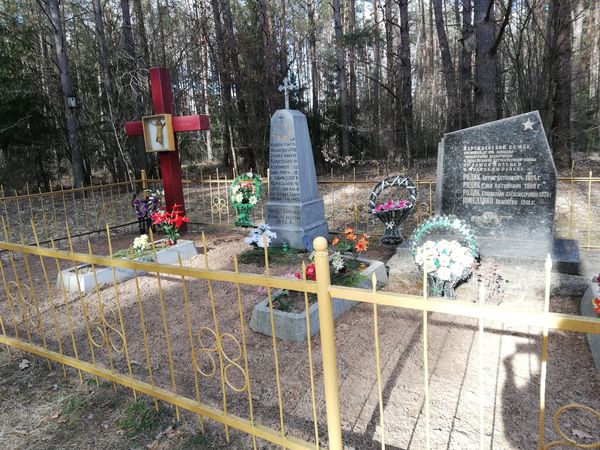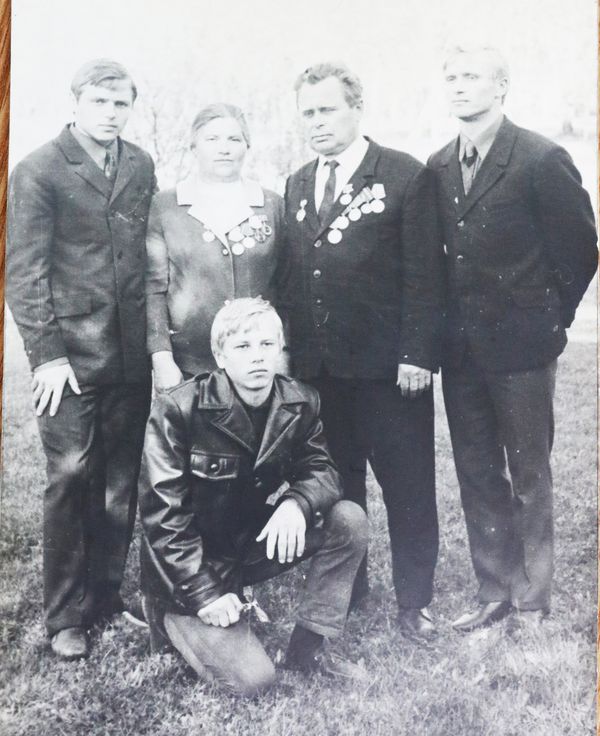A war-scorched village


A small village Paseka-Dvarchany is located in Zabalats village council. It has begun its history since 1897. Now it has 21 residents. In 1940, as the book “Memory” says, 154 people lived there. There were happy moments in the life of the village. They are connected with opening of schools: Polish – in the 30ies of the last century and Belarusian – in 1940. It’s a pity but the life of people was saddened by Nazi congestion. The 26th of October 1943 became the most horrible day in the life of the village history…
TRAGEDY OF PASEKA-DVARCHANY
The Nazi surrounded the village. Terrible news came that the village would be burnt together with people. The charges stemmed either from killing a German soldier by partisans or shootout of the Nazi with soldiers of Polish Army under Gudsinishki. All the villagers were gathered by German soldiers at the end of the village and ordered to dig pits. Death penalty has been waited for a day – an officer had to come from Sabakintsy ( now Pershamaisk of Shchuchin district). At that time all the villagers were let go. But blood violence was committed all the same. The inhabitants of the village recalled (from the notes of Historical Museum of Ethnography “Heritage” in Zabalats):
Frants Rodsik: “ The Nazi learnt from headman Bugatka that many members of our family were connected with partisans and decided to surround the farm.”
“We were sitting in ambush in the forest near the farm. We felt anxious because we heard the shots but didn’t know what had happened. Then I saw my sister with a niece running and whistling, I answered. I came and asked: “Anya, what has happened, are there any Nazi with you?” “No, - she answered, - there aren’t any ! My mum, mummy…” – I understood everything.”
Hanna Rodsik (Zastsenchyk) : “I could have been among the killed. I was among the captured in that shed. When gunfire rang out – they were killing the men, my mum shouted to me and my niece Vladya: “Save yourselves!” We together with the child rushed into the chaff and hid there. Bullets whistled over our hiding place. In a few minutes everything became quiet. It was dead silence. The air smelled powder smoke. Something blinked in my head: “I should run”. I went out of the shed and saw my mum who wrapped her arms around her grandson, near – a puddle of blood. They were dead. We rushed into the safe forest. A little niece cried all the time and asked: “Why did we leave granny alone?” She didn’t understand that she would never see granny.”
Yuzef Klimasheuski: “ I stayed without mother, father, three brothers and two sisters at the age of 10 in October 1943. I was wounded during the shooting, my finger was injured badly. Mother covered me with her body while falling. I don’t remember how I turned out at my aunt’s in the village Dsetki”.
On the 26th of October the children and the women were killed in the shed, and the men - in the yard. Next day dead bodies were burnt. Then the rest were buried. The women with the children in one grave, the men – in the other. Some teenagers were able to save.
Sources give different numbers how many people were shot on that terrible day.Vadsim Maryanski, a young researcher from Zabalats confirms there were 17 of them. Genavefa Matsveeyna Andrushkevich ,a villager of Paseki-Dvarchany told him about this. It became known that Ezhy Antonovich Rodsik who was shot together with Ivan Osipavich Firinovich in May 1944 was also buried here. Firinovich was a partisan, he is buried in Zabalats.
On the 8th of May 1983, fortieth anniversary of blood tragedy members of Voronovo Komsomol organization initiated to install an obelisk from black marble at that place. It is written there: “To partisan family killed by Nazi during the years of the Great Patriotic war from the youth and Komsomol members of the district”.
Countrymen don’t forget the tragedy of the village Paseka-Dvarchany and its villagers. Every year they come and bow their heads as a sign of respect and memory near the grave of victims of fascism. Not one generation of the pupils of Zabalats school does research of the glorious partisan past of the Rodsiks so that descendants know about them.


PARTISAN FAMILY
A great and friendly Rodsik family lived in the village of Paseka-Dvarchany and brought up six children. Anton Frantsavich, father of the family was born in the village of Turya of Shchuchin district. He bought a few plots of pine forest and an old house of the local forester. He took an active part in establishing Soviet power in Zabalats. In autumn 1940 Zabalats village deputy council was formed. His daughter Zoya became chairperson of Zabalats village council, she together with her brothers Frants and Anton joined Komsomol organization. The family was the first to join the collective farm “International” in the center in Zabalats of the former Radun district.

Frants Rodsik recalls: “The collective farm was given three tractors XZS, NATSI, “Universal”. The farm needed specialists to work on them”.
The first tractor drivers were Maria and Frants Rodsik, Zoya Kodsis, Sergey Konan, Tatstsyana Navakoyskaya, Ivan Sidlyarevich. Three best collective farmers were awarded a tour to the All-Union agricultural exhibition in Moscow. The first woman tractor driver Maria Pavyadaika (Rodsik) was among them.
The Great Patriotic War violated the peaceful life. On the third day on the 24th of June 1941 motorized units of the German troops broke into the village of Zabalats. Invaders established “new order”. They were helped by traitors Statskevich, Kaplun and others.
The days of the Rodik family became anxious. Anton Frantsavich left for Shchuchin. He lived in the village of Teikoushchyna, worked on the mill before Radun district was released. Three brothers – Ezhy, Anton and Frants were arrested. They were brought to the commandants office in Zabalats. They had been tortured for some days but then were let go. The Germans got interested in their sister Maria as a soviet activist. She was called in Radun for questioning. She returned a little alive, then went to the partisan detachment.
Zoya Rodsik was on the territory of the former Vasilishki district, was a connector in the group “Friendship” in Dsyatlava and Shchuchin districts. She often took part in fighting operations. She often delivered weapons to the group. Zoya Antonauna recalls: “We were carrying weapons on the coach together with a young partisan. The weapons were covered with straw, and there was a plough on the top. At the railway crossing near the station Razhanka we were stopped by the Germans. Fortunately, they didn’t check in the couch. The partisans were awarded medals “For Courage” for this task.
Ezhy Rodsik who was in Shchuchin district, was a skillful connector . He was appreciated by the partisans from the detachment of Lenin Komsomol. Anton Rodsik organized a secret group, his brother Frants was a member of this group. They gathered weapons for partisans, food products, medicine, necessary information, helped to cure partisans, showed way to the Jews, who escaped from the ghetto, which was near the village of Vasilishki.
In 1943 a partisan detachment, named after Katouski was organized from various groups. The Rodsik family became connectors. Mother Stanislava Alyaksandrauna and younger children baked bread, dried footwear and clothes of the partisans who returned from combat mission at night. It is known that Frants Rodsik was in the partisan detachment named after Katouski, Lenin Komsomol brigade in 1943, and in 1944 in the detachment of Vanda Vasileuskaya. His sister Hanna took part in partisan movement too. In that year they had to hold a fierce battle with the Germans near the village of Novy Dvor of Shchuchin district. In June the partisans blew up the train with German machinery between the stations Skrybautsy and Zhaludok. There was a private partisan Frants Rodsik among demolition men. He was awarded a medal “For Courage”, and later an order of the Great Patriotic War of the second degree. His sister Maria was also awarded a medal “For Courage” for taking part in partisan movement.

P.S. Two descendants of this heroic family, grandsons of the famous Rodsiks – Victar Frantsavich and Uladsimir Frantsavich Rodsik live in Voronovo.
Maryna Kandratovich,
Faina Voishnis, head of Historical Museum of Ethnography “Heritage”,
Vadsim Maryanski, a pupil of Zabalats school.
Translated by Zinaida Tserpitskaya